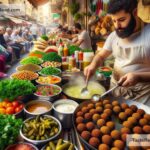Exploring Traditional Dumpling Folding in Sichuan, China
Sichuan Province in southwest China is famous for its vibrant food culture, bold flavors, and heartwarming traditions. Among its many culinary gems, dumplings hold a special place. These little pockets of deliciousness are not just food; they are a symbol of love, family, and history. In Sichuan, dumpling folding is an art passed down through generations. Let’s explore this beautiful tradition and learn why it’s so much more than just cooking!
A Taste of Sichuan Dumplings
Sichuan dumplings, known locally as “shuijiao,” are famous for their spicy, rich flavors. While dumplings can be steamed, boiled, or pan-fried, shuijiao are typically boiled and served with chili oil, garlic sauce, or soy-based dressings. Inside, they are filled with a mix of ground meat (like pork, beef, or chicken), vegetables (such as Chinese cabbage, carrots, and leeks), and fragrant spices.
These dumplings are a true sensory experience. The dough is soft yet slightly chewy, and the filling bursts with flavor. The spicy sauces add heat and complexity, making each bite exciting. But beyond their taste, dumplings have a deeper cultural meaning in Sichuan.
The Tradition Behind Dumpling Folding
In Sichuan, dumpling folding is not just about creating food—it’s about bonding and celebrating. Folding dumplings is typically done during special occasions like Chinese New Year, weddings, or family gatherings. It’s a chance for family members across all generations to come together, roll up their sleeves, and create something meaningful.
For many people in Sichuan, dumpling folding is a skill taught from childhood. Grandparents are often the first teachers, patiently demonstrating how to pinch the dough and shape it into beautiful dumplings. The process isn’t just about making perfect dumplings; it’s about sharing stories, laughing, and strengthening family ties.
How Sichuan Dumplings Are Folded
There are many ways to fold dumplings, and each technique has its own charm. In Sichuan, the most common dumpling shape looks like a crescent, resembling a tiny moon. Here’s a simplified explanation of how it’s done:
-
Prepare the Dough: Dumpling wrappers are typically made from flour and water, mixed into a soft dough. You can buy pre-made wrappers at the market or roll them out yourself for a personal touch.
-
Make the Filling: The filling is a flavorful mix of finely chopped ingredients, such as ground pork, ginger, garlic, soy sauce, and sesame oil. Fresh vegetables like celery or mushrooms are often added for extra texture.
-
Assemble the Dumpling: Place a small spoonful of filling in the center of the dumpling wrapper. Don’t overfill, as it could tear the wrapper when you fold it.
-
Fold and Pinch: Fold the wrapper in half to form a crescent shape. Pinch the edges together tightly to seal the dumpling. Some people pleat the edges for a decorative touch, while others leave it smooth and simple.
-
Cook: Once folded, the dumplings are boiled in water until they float to the surface—this is the sign they’re done. Serve them hot with spicy Sichuan sauces or enjoy them plain.
The Art of Dumpling Pleating
In Sichuan, dumpling pleating is where creativity comes in. Pleating the edges isn’t just about function; it’s about beauty. Master dumpling folders can create intricate patterns, like tight waves or elegant fans, using nothing but their fingers. Some dumpling shapes even have symbolic meanings. For example, dumplings shaped like ingots (ancient Chinese currency) symbolize wealth and prosperity.
Don’t worry if your first dumpling attempts aren’t perfect—it takes practice. In Sichuan homes, beginner dumpling folders are often teased for their wobbly or misshapen creations, but it’s all part of the fun!
Dumpling Folding as a Social Activity
One of the most wonderful things about folding dumplings is how it brings people together. Imagine a large kitchen table surrounded by grandparents, parents, siblings, and friends. Everyone is chatting and laughing as they work. Children may accidentally spill filling everywhere, while the adults share advice on how to make the dumplings look prettier or taste better.
These memories are priceless, and they form a connection between food, tradition, and family. In Sichuan, sharing dumplings is seen as sharing happiness.
How to Experience Dumpling Folding in Sichuan
If you’re visiting Sichuan, don’t miss the chance to participate in dumpling folding yourself. Many cooking schools and cultural centers offer hands-on dumpling workshops for tourists. Local home chefs and restaurants also host dumpling-making classes where you can learn insider tips and tricks.
During these experiences, you’ll not only learn how to make dumplings but also hear stories about their cultural significance. You might even be lucky enough to join a family celebration where dumpling folding becomes a heartfelt group activity.
Conclusion: More Than Just Food
Exploring traditional dumpling folding in Sichuan is a journey into the heart of Chinese culture. Dumplings are a celebration of life, love, and togetherness. From the careful preparation of each wrapper to the joyful connections made around the table, every step in the dumpling-making process is rooted in tradition. And the best part? While enjoying your handmade dumplings, you’ll taste not just the flavors of Sichuan but also the warmth of its people.
So next time you visit Sichuan, gather around a table, fold some dumplings, and create memories that will last a lifetime. Because sometimes, the simplest acts—like folding a dumpling—carry the most meaning.


